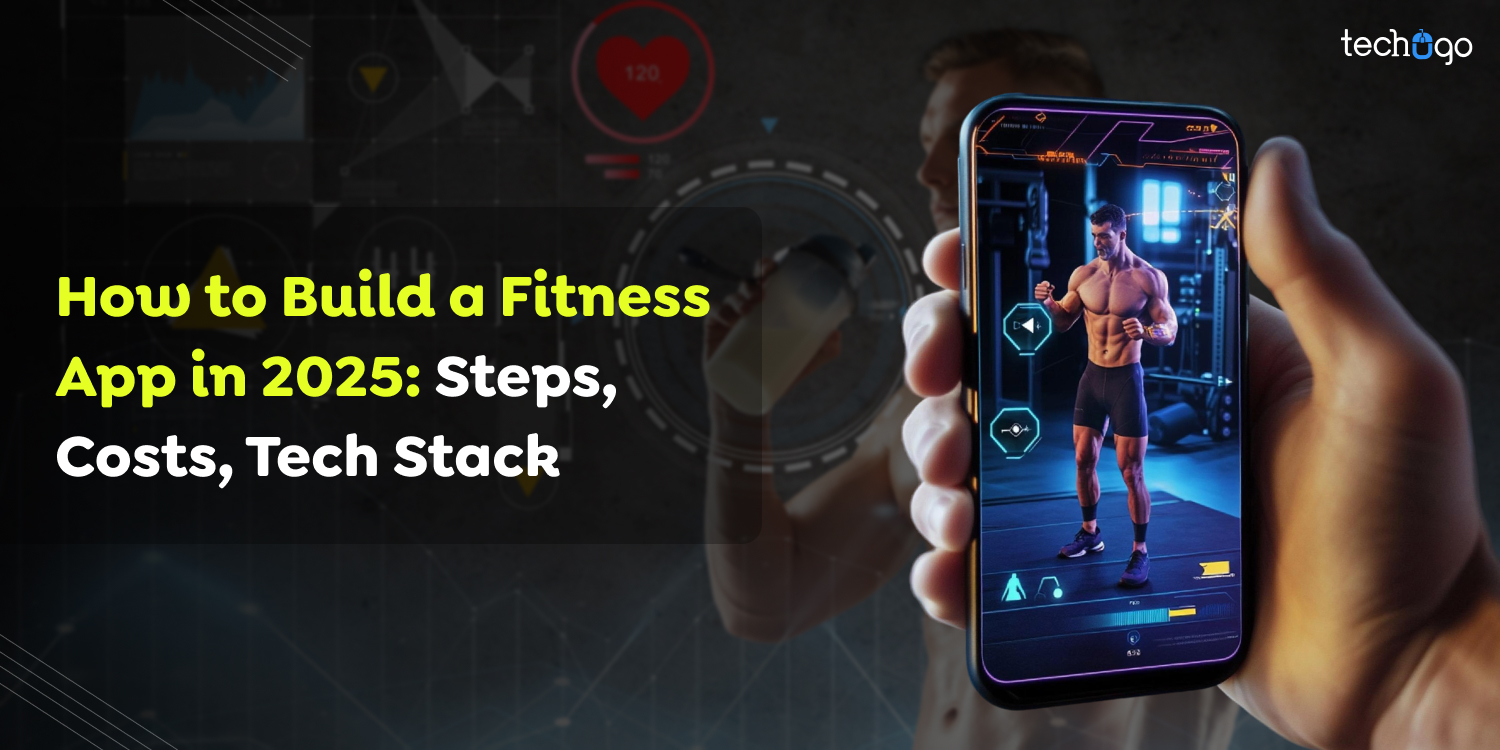20 Feb 2025
How to Build a Fitness App in 2025: Steps, Costs, Tech Stack
Matthew Connor

sFitness apps are increasingly popular today. As more and more people take a greater interest in their physical and mental health, fitness apps have become an essential feature on most smartphones. With the growing focus on healthier living, fitness app development solutions have become a necessity. These apps typically take the form of mobile applications that offer users customized training plans, goal tracking, and data-driven insights to help them achieve their fitness goals.
In Canada, the revenue from the fitness app market is projected to rise to CAD 283.98 million by 2025. It is expected that the revenue will show an annual increase (CAGR 2025-2029) of 5.08%, with the market projected to reach around CAD 346.25 million by 2029.
Essentially, fitness apps are a type of health app that promotes a healthier lifestyle, mental well-being, yoga, and exercise. For this reason, it is important to understand every aspect of creating a successful fitness program and learn how to build an app for your company.
With the right app and marketing efforts, you can increase your market share in this large sector. The question, however, is how to create a fitness app. This requires familiarity with both specific and general factors, such as different types of apps, monetization strategies, and, perhaps most importantly, the development process.
In this article, we will discuss the various aspects involved in the development of fitness apps, including, the cost of fitness app development, key features, and the extensive development process.
What is a Fitness App?
The fitness and health market is growing rapidly due to increased awareness of health and remote living. Nowadays, people need convenience to track their fitness activities and monitor their progress while traveling.
Fitness apps are an ideal way to track your physical fitness and check progress regularly. These mobile apps are created to help users improve their overall health. They come with features that support exercise routines, goal setting, progress tracking, and nutritional advice.
Fitness app development utilizes sensors on smartphones and wearable devices to collect information about fitness, heart rate, and many other parameters. These apps offer users insights into their fitness levels and provide personalized advice. Additionally, they help people achieve their targets more quickly and efficiently.
Types of Fitness Apps
If you take a look at the most popular fitness apps, you know they belong to specific categories of fitness apps? The most important thing to consider is what you aim to accomplish by developing a fitness application. Whether you choose a self-built app or one developed by a fitness app development company, the app’s effectiveness depends on the category it falls under.
Activity Tracking Applications
These apps are designed to track exercises or activities that a user chooses to perform. To calculate the energy burned through activities, the app often tracks steps taken, the pace of each step, time spent on the activity, distance traveled, and more. Certain fitness app development are particularly suited for runners and cyclists, offering more precise measurements of metrics.
Diet & Nutrition Apps
Diet and nutrition apps help users track their food consumption and create personalized meal plans. They can calculate the calories consumed using a vast database when a user records their food and beverages. Based on the provided data, these apps can also generate diet plans and suggest the most suitable exercises for an individual, taking into account factors such as age, weight, height, and gender.
Workout Apps
The most popular category of fitness apps includes those that allow users to exercise. These apps function as personal fitness coaches on your smartphone, offering exercise plans, fitness programs, and workout guides. Users can very easily customise their experience by choosing different exercise levels, frequencies, music, and notifications.
Social Networking Fitness Apps
Fitness apps with social networking features allow users to post their achievements on the platform and track current fitness trends. These apps can encourage users to stick to their workout routines and diets more effectively through group participation. They may also provide live video fitness classes and fitness challenge ideas created by various users. These apps are perfect for those who struggle to stay motivated with their fitness or diet goals.
Benefits of Fitness App Development
Technology’s contribution to health and fitness is significant as we live in a world that is becoming increasingly conscious of personal health. For those who wish to monitor their progress, stay motivated, and enhance their fitness, fitness apps are essential resources.
The advantages that custom fitness app development services offer are:
Establish Brand Authority and Increase Revenue
Creating a custom fitness and health app can boost brand recognition and revenue by providing users with convenience and satisfaction. Available anytime, anywhere, apps like these address the growing demand for health and fitness solutions on the go.
With personalized features such as fitness routines, diet programs, and progress tracking, these apps encourage user loyalty and participation. Direct interaction with customers helps build trust in the brand and increases opportunities for revenue through subscriptions or in-app purchases.
Effortless Customer Communication
Fitness apps enable users to stay fit without the need for gym memberships or attending classes. They facilitate easy and continuous interaction between users and their health routines. Users can track their routines, meals, and workout plans using the apps, ensuring they stay informed and motivated to successfully achieve their fitness goals.
Scale Business Professionally
Fitness app development provides the potential to scale up a business, increasing revenue, expanding the customer base, and enhancing marketing effectiveness. Through technology, businesses can streamline their processes, improve international reach, and enhance brand visibility. This approach not only offers customers personalized experiences but also drives company growth by reaching broader market segments with minimal effort and maximum impact.
Real-Time Analytics Insights
Mobile apps that collect data can significantly boost the success of your fitness company. They provide valuable insights that help you better understand customer behavior. By tracking user interactions and preferences, such as app navigation patterns and the most popular features, you can customize your services to align with user preferences.
This customisation not only improves customer satisfaction but also guides you on how to enhance service quality, add new features, and personalize user experiences. Ultimately, using data-driven insights helps businesses optimize operations, increase user engagement as well as stay ahead of the competition in the ever-changing fitness app market.
24/7 Customer Service Availability
Fitness app development allows users to maintain their fitness routines wherever they are, thanks to extensive activity tracking and monitoring features. Investing in the best fitness app development ensures that you receive top-notch solutions that meet industry needs while improving user satisfaction and engagement. The apps help users achieve their fitness goals by offering convenience and customized instructions, thereby enhancing overall well-being and health.
Enhance Customer Convenience
In an increasingly competitive market, standing out as a professional company requires significant effort. Fitness apps offer a convenient way to showcase professionalism and boost revenue streams. By focusing on delivering personalized wellness and fitness services, they can effectively meet customer needs, establish an authentic brand, and distinguish themselves from competitors. A professional image helps retain and grow loyal customers.
Easy Profile Building
Creating a profile is an essential aspect to consider when launching a fitness app. The app allows users to create accounts by entering basic details, selecting preferences, and monitoring their fitness progress. It’s easy to sign up via email, phone number, or social media to save time. Offering subscription options that include stored billing details improves the user experience and attracts more customers to your app.
How to Develop a Fitness App?
The effectiveness of fitness app development heavily relies on a well-structured approach. Here’s an extensive guide to fitness mobile app development process:
Defining the Scope and Goals
The first and most important step in developing a fitness app is defining its purpose and identifying the target audience. Comprehensive market research and analysis help identify emerging trends, competition, and potential challenges. Be sure to carefully consider the features your app will offer.
Will it specialize in a specific type of fitness routine, track nutrition, or even address mental health and wellness? Once the target audience is identified, the app’s features and layout will be designed to meet their needs. This design approach ensures the app is more efficient and superior to existing applications.
Assemble a Development Team
Consider your budget and then your requirements when deciding between hire in-house developers or partnering with a fitness app development company for outsourcing. We recommend outsourcing, as it is generally more cost-effective than using freelancers or agencies.
A good approach is to research the company’s track record in mobile app development and their passion for fitness. Additionally, they can offer a fresh perspective compared to the one you currently have.
Select the Right Techniques
Native app development is a popular choice for us. We recommend using native development as it is the most efficient method for building a fitness app with optimal performance. If you’re more inclined toward cross-platform fitness app development, we suggest Flutter.
Flutter is now considered an ideal alternative for cross-platform apps, as the performance results are comparable to native apps, while the costs and development time are lower. To take full advantage of these benefits, consider using Flutter for your app development.
Design and Prototyping
This stage involves creating wireframes and examples of the basic design for the fitness app, along with preparing a concept for the app’s development. Once that’s done, you can begin prototyping, testing, and evaluating the results.
It’s essential to ensure that the layout is designed by experts who not only create stunning visuals but also possess the experience to develop an excellent user experience (UX). The fitness app must be developed in a way that is easy for users to navigate, while also considering other factors like design costs for a more balanced approach.
Testing and development
At this point, the app is created following the accepted requirements. It includes backend and frontend development. The front end provides the user’s interface, while the back end is in charge of storage, data processing, and security.
Much of fitness app development time is spent checking and fixing bugs. Quality assurance specialists evaluate the entire user experience of the application, determining whether the elements function as they were intended to and examining the code for any bugs.
Deploy and maintain the app
When you’re nearing the finish line of your process, you’ll find that the fitness app you designed will be available on the app marketplaces. But your obligations aren’t over. Unexpected problems may occur during operation. If this happens, you must check the application’s performance and fix any issues in the shortest time possible. The analytics tools that you can utilize are Google Analytics.
Another thing to consider is that a strong marketing plan and support are required to ensure your app is successful and well-known. Advertise your app in various ways, ensure your training session is updated, and take note of the feedback.
How Much Does Fitness App Development Cost?
Starting fitness app development with an MVP could cost between CAD 30,000 and CAD 50,000, as it will only include basic features. Once you’ve gauged user interest and decide to develop a fully-fledged fitness app, the cost could increase to anywhere between CAD 60,000 and CAD 160,000.
If you intend to include AI, ML, Bluetooth with hardware connectivity, as well as video and voice integration, your cost could range from CAD 20,000 to CAD 30,000. Outsourcing and hiring mobile app development services gives you an advantage, as we can provide an accurate estimate of your project costs based on your budget, timeline, and features.
To get a rough estimate for the basic MVP, the documentation stage could take up to 70+ hours, while the creation and development phases might require around 900+ hours.
The cost of fitness app development depends on a variety of factors, such as:
- Features
- Complexity
- UI/UX design
- Platform compatibility
- Compliance with regulations
- Location
- Expertise of the company
How Can You Make Money Through Fitness App Development?
The fitness app can turn into a money-making machine with basic features available on a complimentary basis and charging fees for the premium features, such as personalized workouts or meal plans. Making money by selling workout equipment and accessories and joining brands to offer sponsored content or product promotions can generate additional revenue.
In-app purchases
Another option is offering additional features not available within the free version of the app. They could include anything from customized instruction plans to direct assistance with coaching. The model is flexible enough to combine revenue strategies, improve the user experience, add value, and grow revenues. This model draws users by offering unique features that encourage them to take the time to invest in better functionality and customer service.
Subscription Model
Both Subscription plans and one-time purchases are revenue methods for fitness applications. Subscription plans can yield more profit in the long run, but they require convincing customers that the app is worth their time. It is essential to create a memorable application experience that is worth regular fees. Single-time purchases are simple but could limit the potential for revenue. Finding a balance between price and pricing is vital to maximizing your fitness application’s value.
Advertising
The most common way to earn money for fitness apps is to offer the application for free while also earning money through advertising. The business can select between joining advertisers or using ad networks.
Working directly with advertisers may yield more money, but setting up requires more effort. Ad networks are simpler; however, they can result in lower profits. It is important to remember that this strategy could cause frustration for users due to the existence of advertisements, which can negatively impact users’ experience. So, careful thought is recommended when choosing this type of revenue model.
Sponsorship deals
Collaborating with sponsors that offer to share their information with you or direct them to their stores online or websites is also possible. Another option to earn cash is to recommend and earn commissions for fitness-related products or services purchased by users according to your recommendations.
Tech Stack Use to Build a Custom Fitness Application
Nowadays, fitness app development offers significant advantages over exercise classes that take place offline. They are easy to access, and economical. Businesses are also looking for ways to increase the user experience, usability and the overall experience for users. This is the reason why technologies are advancing rapidly for fitness app development.
Native App Development
Native apps harness the full capabilities of smartphones to deliver unbeatable speed and seamless user experience. Through the use of languages and software made specifically to work on iOS or Android platforms, programmers can access advanced features such as augmented reality to create live fitness classes, real-time heart rate tracking, and more immersive and enjoyable user experiences.
The true beauty lies not only in choosing the right technology but in how it can be used to improve an individual’s health. An experienced app development company understands that every line of code contributes to a user’s health and fitness goals, making it more than just an app.
Web App Development
Developing web-based apps for fitness platforms involves similar challenges and opportunities. Technologies like AngularJS and NodeJS provide a solid foundation for building responsive and flexible web applications.
Users can enjoy the convenience of accessing their fitness apps across multiple devices, eliminating the need to download a specific app and enhancing accessibility. This accessibility is key to promoting a community-oriented fitness culture, breaking down barriers to fitness, and ensuring it is available to everyone.
The selection of these tools for fitness app development services is based on the idea of providing an accessible experience where every user interaction with the web application promotes a healthy lifestyle. Additionally, using Progressive Web Apps (PWAs) offers a native-like experience, resulting in apps that are both highly accessible and fast.
Front-End Development
The interface of the fitness app is where users interact with a digital representation of their goals and progress. More than just a display, it’s about creating a simple and enjoyable environment that promotes frequent use and fosters a positive relationship with fitness.
Technologies like AngularJS for web-based apps, as well as Swift, Kotlin, Java, and Objective-C for native mobile apps, are essential for creating attractive and user-friendly interfaces. The choice of front-end technology plays a crucial role in translating complex fitness data and tracking features into an easy and enjoyable user experience.
An experienced fitness app development company can combine creativity and expertise to create a fitness app that aligns with users’ fitness goals, ensuring that every click, swipe, and interaction brings them closer to achieving their objectives.
Back-End Development
The back-end of fitness apps is the engine that powers the app’s functionality, managing data servers, server interactions, and connecting to third-party applications. Technologies such as Node.js and Ruby on Rails offer exceptional scalability and performance, allowing the app to handle increasing numbers of users and large data sets without affecting speed.
However, one aspect that is often overlooked in back-end development discussions is the importance of privacy and security, particularly when it comes to very sensitive fitness and health information.
A fitness app developer prioritizes implementing robust security measures, like encryption and secure authentication protocols, to protect user data. They also help design back-end systems with flexibility in mind, allowing you to seamlessly integrate new features and applications. For example, they can connect to wearable devices and provide AI-driven customized workout programs, keeping up with the constantly evolving fitness industry.
Third-Party Integrations
Integrating third-party apps into a fitness app can significantly enhance its capabilities and user experience by providing services like social media sharing, payment processing, and advanced analytics. The selection and combination of these tools requires a strategic planning approach that goes beyond technical compatibility. A fitness app development firm focuses on the overall fitness experience and aims to integrate useful features into the application.
For instance, integrating a nutrition tracking app can complement physical exercise routines, offering customers a comprehensive health monitoring solution. Additionally, adding community-building tools like challenges, leagues, or social sharing can leverage the positive aspects of fitness in a group
App Development Frameworks
Using native frameworks such as Cocoa Touch, Dagger 2, and Gradle offers distinct advantages in terms of performance and access to the latest technology on the platform. However, cross-platform frameworks like React Native and Flutter are highly efficient for speeding up development time and reducing costs when the app does not require extensive native capabilities.
Conclusion
The rapid growth of smartphones, wearables, and AI-driven personalized and on-demand fitness services make up the majority of the global market. The development of fitness apps presents huge opportunities for businesses. Companies that specialize in custom healthcare app development can create apps that appeal to fitness enthusiasts by focusing on user-centered designs and features such as fitness tracking and personalized fitness programs.
Examining your company’s requirements as well as market expectations will aid in creating fitness app that will thrive and beat its rivals. Create an app that is value-driven for its target users, by taking into consideration the requirement for fitness apps that are user-friendly.
Fitness and health apps are extremely popular right now and the future is positive. However, as the market increases, so do competitors. It is therefore crucial to choose a seasoned firm for mobile app development who has the necessary expertise. It will ensure that your original idea is implemented with a high level of quality and speed, making the app stand out.
Get In touch
We are excited to here from you and let’s start something special Together. Call Us for any inquiry.
Write us
sales@techugo.caJust a call away
About you




